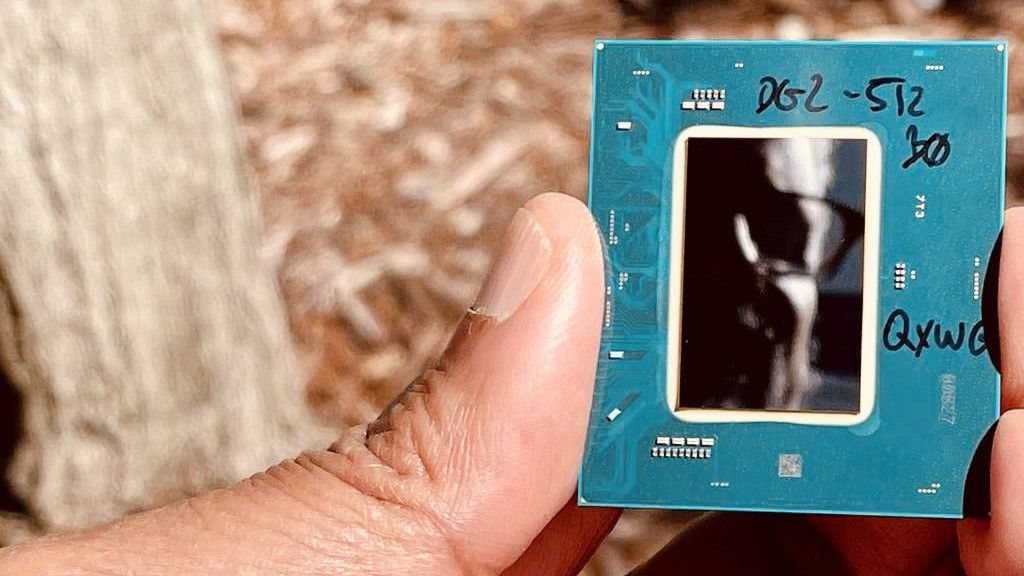Intel’s high-end gaming GPU could threaten Nvidia – perhaps with a little help from AMD
GPU promises ‘buttery smooth’ performance, and could use AMD’s FSR tech

Intel’s incoming heavyweight gaming GPU has been shown off on Twitter, complete with an assertion that it’s going to be capable of some seriously smooth frame rates.
Obviously at this stage, we can take any such claims with more than a few liberal pinches of salt – Intel is still very much building up a cloud of hype steam, as it were. But it’s good to hear that the Xe-HPG (high-performance gaming) GPU is shaping up to be a capable force, and to see an actual pic of DG2 (as the card is also referred to, being the sequel to Intel’s first discrete offering, DG1).
Xe-HPG (DG2) real candy - very productive time at the Folsom lab couple of weeks ago. “From jittery journeys to buttery smooth” said @rogerdchandler - lots of game and driver optimization work ahead for @gfxlisa’s software team. They are all very excited..and a little scared:) pic.twitter.com/tQcfEWf8p4June 2, 2021
The tweet is from Raja Koduri, chief architect (and senior VP) of the graphics division at Intel, but the comment about the smoothness is from Roger Chandler, Intel’s GM of Client XPU Products. Chandler describes progress made on the GPU as: “From jittery journeys to buttery smooth.”
- We'll show you how to build a PC
- These are the best processors
- Amazon’s Prime Day 2021 sale starts soon
As you can see from the chip shown, this is the DG2 variant with 512 Execution Units, and going by previous rumors, this will be the flagship gaming graphics card.
AMD FSR FTW?
As Wccftech, which spotted the above tweet, points out, Koduri replied in another tweet when questioned about whether Intel might adopt AMD’s DLSS rivalling FSR tech (FidelityFX Super Resolution).
Definitely looking at it - the DL capabilities of Xe HPG architecture do lend to approaches that achieve better quality and performance. We will definitely try to align with open approaches to make ISVs job easier..June 2, 2021
AMD just confirmed at Computex that FSR will debut later in June, and rather than Nvidia’s proprietary DLSS, Team Red’s take on frame rate boosting will be an open standard. Indeed, AMD already demonstrated it working on an Nvidia GTX 1060 graphics card with Godfall – so theoretically, this is something Intel could benefit from, rather than trying to brew its own image upscaling potion.
As Koduri makes clear, this is something Intel is “definitely looking at” and that the firm would want to “align with open approaches” (meaning FSR) in the cause of making things easier for game developers. (Introducing another separate standard – like ‘XeSS’ which has been rumored before – would complicate matters further, of course, and would likely be a major uphill struggle for Intel in terms of trying to push devs to adopt).
Sign up for breaking news, reviews, opinion, top tech deals, and more.
The long and short of it is that AMD’s technology could help Intel’s new gaming graphics cards better rival Nvidia, and indeed Team Red’s own GPUs for that matter.
Intel’s Xe-HPG card might appear before 2021 is out – and indeed this pic is a hopeful sign that things are on schedule – but a recent rumor indicated that early 2022 is a more realistic proposition, at least for the desktop GPUs (mobile versions of DG2 for gaming laptops are purportedly set to arrive first).
- These are the best graphics cards
Darren is a freelancer writing news and features for TechRadar (and occasionally T3) across a broad range of computing topics including CPUs, GPUs, various other hardware, VPNs, antivirus and more. He has written about tech for the best part of three decades, and writes books in his spare time (his debut novel - 'I Know What You Did Last Supper' - was published by Hachette UK in 2013).